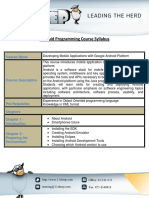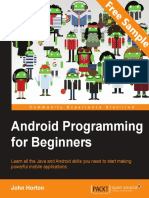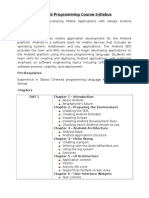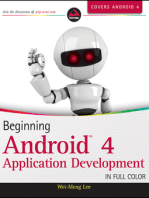Android Development Steps
Uploaded by
Marjan TanevskiAndroid Development Steps
Uploaded by
Marjan TanevskiAndroid Programming with Java Basics Course Description
The Android platform is the fastest growing mobile development platform in the world. With Android phones being produced by all of the major phone manufacturers, and the addition of new tablet devices, the platform will only continue to grow. NetCom's 7-day Android Programming course will teach application development for the Android Development using the Java Programming Language and the Eclipse Development Environment. This course will include basic application development including use of the Android phone camera, geolocation tools, and playing audio and video files.
Intended Audience for the Android Programming with Java Basics Course
Preferably anyone with basic familiarity with Java programming, who wants to learn how to get started with Android applications. However, a programmer with no background in Java should be able to pick things up very quickly.
Training Packages & Career Tracks that include the Android Programming with Java Basics Course
Mobile Development Professional Career Track: Computer Programmer
Android Programming with Java Basics Course Objectives
Learn the basics of Android. Understand the application lifecycle. Write simple GUI applications. Use built-in widgets and components. Work with the database to store data locally. Build your own Android apps Explain the differences between Android and other mobile development environments Understand how Android applications work, their life cycle, manifest, Intents, and using external resources Design and develop useful Android applications with compelling user interfaces by using, extending, and creating your own layouts and Views and using Menus. Take advantage of Android's APIs for data storage, retrieval, user preferences, files, databases, and content providers Tap into location-based services, geocoder, compass sensors, and create rich map-based applications Utilize the power of background services, threads, and notifications. Use Android's communication APIs for SMS, telephony, network management, and internet resources (HTTP). Secure, tune, package, and deploy Android applications
Android Programming with Java Basics Course Outline
I. Creating Basic Java Applications 1. Creating Applications in Packages 2. Java Variables 3. Java Conditionals and Loops 4. Java Arrays 5. Java Array Lists Java Object Oriented Concepts Review* 1. Creating a Java Class
II.
III.
IV.
V.
VI.
VII.
VIII.
IX.
X.
XI.
XII.
XIII.
2. Improving the Java Class 3. Using Inheritance 4. Understanding Interfaces 5. The Static Context Creating Your First Android Applications 1. The Hello World Application 2. Working with the Emulator 3. Strings 4. Drawables 5. Introducing the Manifest 6. Understanding the Activity Lifecycle Creating Listeners 1. Listeners Using an inner class 2. Listeners Using an interface 3. Listeners By Variable Name 4. Long Clicks 5. Keyboard Listeners Understanding Android View Containers 1. Linear Layout 2. Relative Layout 3. Table Layout 4. List View Android Widgets Part I 1. Custom Buttons 2. Toggle Buttons 3. Checkboxes and Radio Buttons 4. Spinners Android Widgets Part II 1. Autocomplete Text Box 2. Map View 3. Web Views 4. Time and Date Pickers Communicating Between Activities 1. Switching Activities 2. Putting Extra 3. Using Shared Preferences Storing Information on the Device 1. Internal Storage 2. External Storage 3. Web Communication and Storage Audio and Video 1. Playing Audio with the MediaPlayer 2. More Audio Options 3. Playing Video with the MediaPlayer 4. Recording and Storing Audio Content Custom List Views 1. List Activities with Custom Layouts 2. List Activities with Custom Adapters 3. Displaying multiple items in a List View Integrating Web Services 1. Text Based Web Services 2. Sending data to a Web Services 3. Integrating a JSON based web service Creating Home Screen Widgets 1. Creating the Widget Background
XIV.
XV.
XVI.
2. Placing and Updating the Widget 3. Events on the Widget Drawing and Animation 1. The Android Drawing API 2. Animation with XML 3. Programatic Animation Geolocation 1. Determining Location 2. Integrating Google Maps Camera Hardware 1. Taking Pictures and Saving in the Album 2. Recording Video Content
You might also like
- New Criterion For Jetting, Conductor Design100% (2)New Criterion For Jetting, Conductor Design35 pages
- Part 1:-Android - The Big Picture: 1. A) B) I) Ii) Iii) Iv) V) Vi) C)No ratings yetPart 1:-Android - The Big Picture: 1. A) B) I) Ii) Iii) Iv) V) Vi) C)8 pages
- Android Programming For Beginners - Sample ChapterNo ratings yetAndroid Programming For Beginners - Sample Chapter50 pages
- Beginning Android Programming: Develop and DesignNo ratings yetBeginning Android Programming: Develop and Design7 pages
- Program Android App For Beginners Self-Paced 2019No ratings yetProgram Android App For Beginners Self-Paced 201911 pages
- Mobile Application Development Course Outline100% (1)Mobile Application Development Course Outline3 pages
- Android Development: Course Catalog 2012-2013No ratings yetAndroid Development: Course Catalog 2012-20133 pages
- Android App Development: Eighteen Weeks Summer Training ReportNo ratings yetAndroid App Development: Eighteen Weeks Summer Training Report28 pages
- Android Apps Development: Mode: Classroom Duration: 40 Hours Course ContentsNo ratings yetAndroid Apps Development: Mode: Classroom Duration: 40 Hours Course Contents1 page
- GA :: Android Developer Immersive SyllabusNo ratings yetGA :: Android Developer Immersive Syllabus2 pages
- (Paul Cardle) Android App Development in Android S (B-Ok - Xyz) PDFNo ratings yet(Paul Cardle) Android App Development in Android S (B-Ok - Xyz) PDF202 pages
- Download Full Android Cookbook Problems and Solutions for Android Developers 2nd Edition Ian F. Darwin PDF All Chapters100% (2)Download Full Android Cookbook Problems and Solutions for Android Developers 2nd Edition Ian F. Darwin PDF All Chapters55 pages
- ANDROID APPLICATION COURSE CONTENT Atc PDFNo ratings yetANDROID APPLICATION COURSE CONTENT Atc PDF7 pages
- Android App Development For Beginners: DescriptionNo ratings yetAndroid App Development For Beginners: Description13 pages
- Android Roadmap Learning Resources by ASSIST SoftwareNo ratings yetAndroid Roadmap Learning Resources by ASSIST Software1 page
- Android Application Development Cookbook - Second Edition - Sample ChapterNo ratings yetAndroid Application Development Cookbook - Second Edition - Sample Chapter29 pages
- Summer Internship Course On Advanced Android & Web Application DevelopmentNo ratings yetSummer Internship Course On Advanced Android & Web Application Development7 pages
- Android Programming A Step by Step Guide For Beginners!100% (5)Android Programming A Step by Step Guide For Beginners!131 pages
- Computer Collegiate: Introduction To Android Application DevelopmentNo ratings yetComputer Collegiate: Introduction To Android Application Development2 pages
- Android Wireless Application Development Vol I Android Essentials 3rd EditionFrom EverandAndroid Wireless Application Development Vol I Android Essentials 3rd EditionNo ratings yet
- Mastering the Art of Android Programming: Unraveling the Secrets of Expert-Level ProgrammingFrom EverandMastering the Art of Android Programming: Unraveling the Secrets of Expert-Level ProgrammingNo ratings yet
- Refinements v0.1: A Step Towards Keeping The Backlog Clean and OrderlyNo ratings yetRefinements v0.1: A Step Towards Keeping The Backlog Clean and Orderly7 pages
- What Impacts Confidence: Genes Social Environment The Choices You Make 1. Picture The Success 2. Beleive in Your Ability To Improve (Improve Muscles, Develop Growth Mindset) 3. Practice FailureNo ratings yetWhat Impacts Confidence: Genes Social Environment The Choices You Make 1. Picture The Success 2. Beleive in Your Ability To Improve (Improve Muscles, Develop Growth Mindset) 3. Practice Failure1 page
- Impacts of Human-Wildlife Conflict in Developing C PDFNo ratings yetImpacts of Human-Wildlife Conflict in Developing C PDF6 pages
- Microprocessors and Microcontrollers/Coprocessor Multiple Choice QuestionsNo ratings yetMicroprocessors and Microcontrollers/Coprocessor Multiple Choice Questions2 pages
- Ce-102 (A) Statics & Dynamics - Questions2No ratings yetCe-102 (A) Statics & Dynamics - Questions27 pages
- Svm/Svmi E-Series Prompts and Prompts Utility: Voice StudioNo ratings yetSvm/Svmi E-Series Prompts and Prompts Utility: Voice Studio27 pages
- Test Bank for Campbell Essential Biology, 5th Edition: Simon PDF Download Full Book with All ChaptersNo ratings yetTest Bank for Campbell Essential Biology, 5th Edition: Simon PDF Download Full Book with All Chapters40 pages
- How To Record A Guitar Track Using Adobe Audition 1No ratings yetHow To Record A Guitar Track Using Adobe Audition 110 pages
- Chapter 2 - Frequency Distributions and Graphs: Limits Boundaries FNo ratings yetChapter 2 - Frequency Distributions and Graphs: Limits Boundaries F20 pages
- A+ Blog-Class-8-First Bell-Physics-Chapter-5-Class-29-Notes (Em)No ratings yetA+ Blog-Class-8-First Bell-Physics-Chapter-5-Class-29-Notes (Em)3 pages
- Biology Lab Assistant Manual: From The Department Chair .No ratings yetBiology Lab Assistant Manual: From The Department Chair .6 pages






























































































